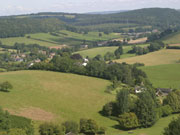 |
 |
 |
 |
While researching my family history, I decided to see what I could discover about Hope Mansell (where I live) since the earliest English Census, which took place in 1841, and although later Censuses included more information 80 years of Censuses gives one a great snapshot of the village. The most recent one available online is the 1911 Census, and it will be a few years before 1921 is released.
The biggest difficulty is that most of the cottages and smaller houses had no name (presumably because the residents received little or no post, so names were not needed), we just have the names of the residents, and it is not always easy to work out where they were, so, for example, in 1841 the Baker family (father was a blacksmith) lived somewhere near Hopes Ash, while the Evans family (father a labourer) lived between 'Rook' and Moat. The named farms which we still see through the village today were all occupied by farmers, their children, and from two to five servants ranging in age from 10 to 36 - some also had lodgers. The Rectory was occupied by Henry Biss, his wife, two daughters and two servants.
By 1851 the Census tells us how much land each farmer is farming, although one farm seems to be occupied by a labourer, and the rectory is occupied by a laundress and her son. In 1851 Cowles is occupied by William James, Carpenter and Wheelwright and his family, who remain there for the next 60 years with William's son George taking over the business and still working aged 72 in 1911, while his sister Lydia was working as postmistress at the time of the 1891 Census. Father and son James must have fallen out at one point as in 1871 George is lodging just down the road!
In 1861 two of the farms are being run by women, with labourers and servants to help, while the Rectory once again has a Rector, William York Draper who is obviously rather posh, as his wife has a lady's maid, and the household includes a cook and two housemaids, while the Rector's daughter was born in the Palace of Holyrood, in Edinburgh, so he was well travelled compared with the locals.
Unfortunately the enumerator of the 1871 Census did not name any of the houses, so who lives where is guess work, but one can make certain assumptions.
The Rector has changed again to Thomas Richmond, his wife, son and stepdaughter with only one general domestic servant. In 1881 the Rector has changed again to the unmarried Charles Alexander Borner who lives with his sister and and cook and parlourmaid. It is the first time the Forge is named, run by Richard Tummy, Blacksmith and Farmer, with his wife and a farm labourer, then by 1891 The Forge is being run by William Heaven, Blacksmith, and his wife, with their two small children, and they are still there in 1901 with four children, when the forge is also the Post Office. 1881 is also the last mention of Cornelius Marfell of Street who seems to have had a rather lonely life: in 1841 he was 35, living with his wife Abiah (quite a common name in the the earlier Censuses), and 3 year old son George, with four servants, however his son died on 17th January 1844. By 1851 he has been widowed, but is still farming 110 acres with Elizabeth Reynolds and George Richardson as house and farm servants respectively. By 1861 he is still farming, with Elizabeth and George assisting, plus 3 other (unnamed) men. He is farming in 1871, but by 1881 he has retired and trusty Elizabeth is still with him, until in 1891 Street is uninhabited. Cornelius lived to a ripe old age for the late 19th Century. Street was occupied again in 1901 but by a carter on a farm, so I make the leap of assumption that it was rented, and likewise in 1911 a widow and her sister were working as laundresses. Marfell's again inhabited Street later that century, but I do not know if they were related to Cornelius.
The first time the School House is listed that I could find was in 1891, when John Louch was Schoolmaster, with his wife Emma assisting, but by 1901 Albert Smith and his wife Eliza were Schoolmasters there. In 1891 there is yet another Rector, Walker Eaton aged 75 and his wife Isabella 62, with their son who is 42 and living on a Civil Service Pension. They also have a cook and housemaid, and a Nurse Attendant, so presumably either wife or son are disabled in some way. Ten years later the Rector is Charles J Stuart Rotten, with wife and a single servant, and the household was the same in 1911.
What has interested me the most is that other than one farm in the village (which I believe has been in the same family for centuries), none of the families of the inhabitants of Hope Mansell in 1911 are still living in the village (do not hesitate to put me right!). Farmers, labourers, coalminers, lime burners came and went again, but they were overwhelmingly born within a few miles, if not in Hope Mansell itself. Servants came from East Dean, Walford, Gorsley and Weston, and in rare cases from further afield. It was very much a farming community, with the occasional retired farmer or attorney living off independent means. The final surprise to me was the number of (live-in) female domestic servants the farms employed (and how young they started), but I assume they were dairy maids as well as general domestics, unless anyone can give another reason!
One last comment: the Censuses use Hope Mansell and Hope Mansel interchangeably, according to the whim of the enumerator each year.
Caroline Elmitt